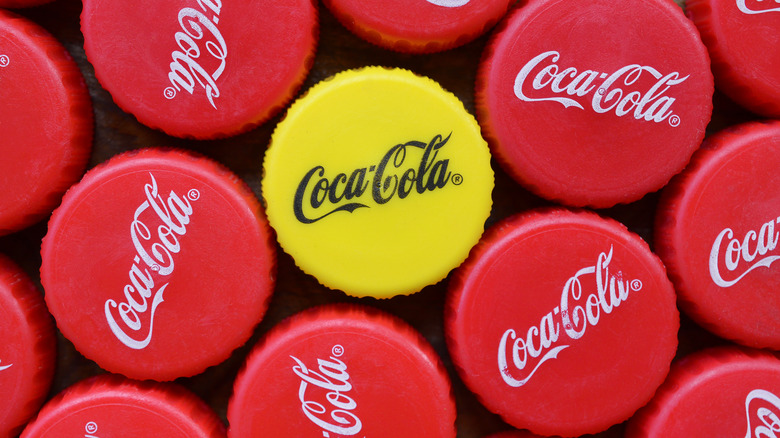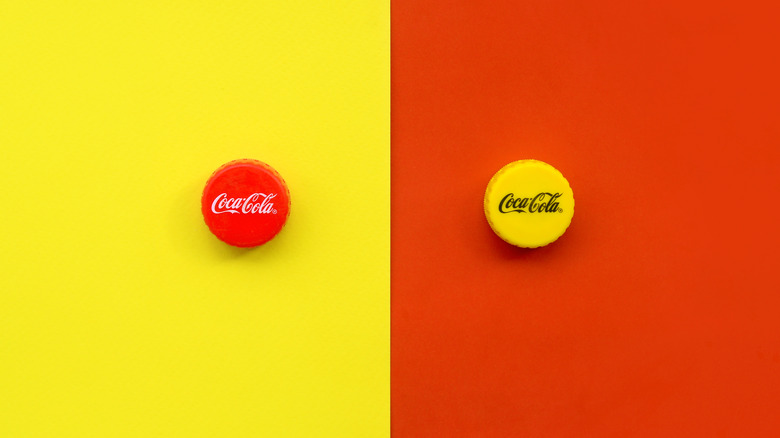What Does It Mean When A Coca-Cola Bottle Has A Yellow Cap?
Since 1886, Coca-Cola has become one of the world's most beloved drinks (via Coca-Cola). While selling an average of 1.9 billion servings of the soda every day, it also stands as a commonality between all people and cultures throughout the world, gathering people together in the common love for the sweet drink (via Coca-Cola).
While many people opt for the original flavor of Coca-Cola, the famed soda has gone through several new editions throughout the decades. Listening to the wants of its global customers, Coca-Cola comes in many different shapes and sizes, including Diet, Cherry, and Cherry Vanilla, according to the website. In 2018, the company launched its diet "High Line" collection, infusing some new fruity flavors into its cola recipe, including Ginger Lime, Feisty Cherry, Zesty Blood Orange, and Twisted Mango.
While listening to customers is crucial to the ultimate success of any company, that's where Coca-Cola goes above and beyond. If you haven't noticed, Coca-Cola has distributed bottles of its drink with yellow caps around the same time each year for the past several decades. You might wonder what the cause of the cap change may be, considering they're only around for a month or two at a time. Taking a closer look, it goes pretty deep.
The yellow caps have a special meaning
If you've stepped foot in any convenience or grocery store recently, you might have seen that some Coca-Cola bottles have yellow caps on them. They're pretty easy to spot among their usual red-capped counterparts. If you come across a yellow-capped Coca-Cola bottle, it's there for a reason.
According to Today, these yellow caps are indicators for those who celebrate Passover. During Passover, people of the Jewish faith practice eating "kosher" foods, or foods that are "satisfying the requirements of Jewish law" (via Google Dictionary). During Passover, Jewish people cannot eat or drink anything that is not labeled as kosher, including anything leavened. This includes foods or fermented drinks coming from wheat, barley, oat, spelt, or rye (via TODAY).
While Coca-Cola used to be made with cane sugar, most of what is sold in the United States is sweetened and made from high-fructose corn syrup. This does not meet the kosher standard. However, the yellow caps on Coca-Cola bottles are a special indication to those celebrating Passover that that bottle was flavored with non-corn-based sweeteners. The caps are also stamped with the official Passover kosher certification symbol "U-O-P" for added assurance (via Insider). These bottles are actually "healthier" than any other red-capped bottles because they are certified using real sugar instead of artificial sweeteners, like high-fructose corn syrup.
Other foods that celebrate Passover
According to Jewish Times, in the 1930s, an Atlanta rabbi named Tobias Geffen decided to look into what ingredients actually went into widely available foods and drinks to see what would be deemed kosher-friendly. Rabbi Geffen's efforts led Coca-Cola to create a version of their product that could be consumed during Passover.
Another food that has been made Passover-friendly is sushi. Because sushi is usually made with rice, it isn't fit for eating during Passover. It can be, though, if it's made with quinoa, instead. Today, there is specific quinoa produced and packaged that meets kosher standards (via Jewish Times). The same goes for oil. During Passover, oil trucks are usually washed and inspected by rabbis before they can be reloaded with oils, making sure no corn oil is around or contaminates other oils.
It's pretty cool if you think about it, knowing that companies will hear the concerns of their consumers' and make changes where they're due.


